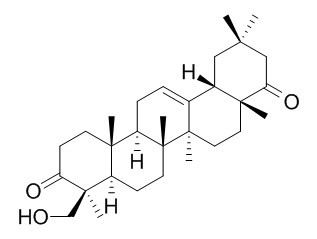Melilotigenin B
Reference standards.
Inquire / Order:
manager@chemfaces.com
Technical Inquiries:
service@chemfaces.com
Tel:
+86-27-84237783
Fax:
+86-27-84254680
Address:
1 Building, No. 83, CheCheng Rd., Wuhan Economic and Technological Development Zone, Wuhan, Hubei 430056, PRC
Providing storage is as stated on the product vial and the vial is kept tightly sealed, the product can be stored for up to
24 months(2-8C).
Wherever possible, you should prepare and use solutions on the same day. However, if you need to make up stock solutions in advance, we recommend that you store the solution as aliquots in tightly sealed vials at -20C. Generally, these will be useable for up to two weeks. Before use, and prior to opening the vial we recommend that you allow your product to equilibrate to room temperature for at least 1 hour.
Need more advice on solubility, usage and handling? Please email to: service@chemfaces.com
The packaging of the product may have turned upside down during transportation, resulting in the natural compounds adhering to the neck or cap of the vial. take the vial out of its packaging and gently shake to let the compounds fall to the bottom of the vial. for liquid products, centrifuge at 200-500 RPM to gather the liquid at the bottom of the vial. try to avoid loss or contamination during handling.
Vet World.2023, 16(3):618-630.
Biochem Biophys Res Commun.2020, 527(4):889-895.
Arch Biochem Biophys.2024, 759:110111.
Journal of Applied Pharmaceutical Science2022, 0(00), pp:001-007
Int Immunopharmacol.2023, 125:111175.
Molecules.2021, 26(6):1635.
Oncol Rep.2019, 41(4):2453-2463
Biomed Pharmacother.2021, 137:111362.
Cell Biochem Funct.2018, 36(6):303-311
Neuropharmacology2019, 151437
Related and Featured Products
Phytochemistry Letters, 2015, 13:165-170.
Triterpenoid saponins from the aerial parts of Trifolium argutum Sol. and their phytotoxic evaluation.[Reference:
WebLink]
METHODS AND RESULTS:
Four triterpenoid saponins (1–4) were isolated from the aerial parts of Trifolium argutum Sol. (sharp-tooth clover) and their structures were elucidated by comprehensive spectroscopic analysis, including 1D and 2D NMR techniques, mass spectrometry and chemical methods. Two of them are new compounds, characterized as 3-O-[α-l-rhamnopyranosyl-(1→2)-β-d-galactopyranosyl-(1→2)-β-d-glucuronopyranosyl]-3β,24-dihydroxyolean-12-ene-22-oxo-29-oic acid (1) and 3-O-[β-d-galactopyranosyl-(1→2)-β-d-glucuronopyranosyl]-3β,24-dihydroxyolean-12-ene-22-oxo-29-oic acid (2). The occurrence of 3β,24-dihydroxyolean-12-ene-22-oxo-29-oic acid (melilotigenin) in its natural form is reported for the first time as a triterpenoid aglycone within Trifolium species. The phytotoxicity of compounds was evaluated on four STS at concentration 1 μM to 333 μM.
CONCLUSIONS:
Compound 1 was the most active, showing more than 60% inhibition on the root growth of L. sativa at the higher dose, with IC50 (254.1 μM) lower than that of Logran® (492.6 μM), a commercial herbicide used as positive control. The structure–activity relationships indicated that both aglycones and glycosidic parts may influence the phytotoxicity of saponins.



